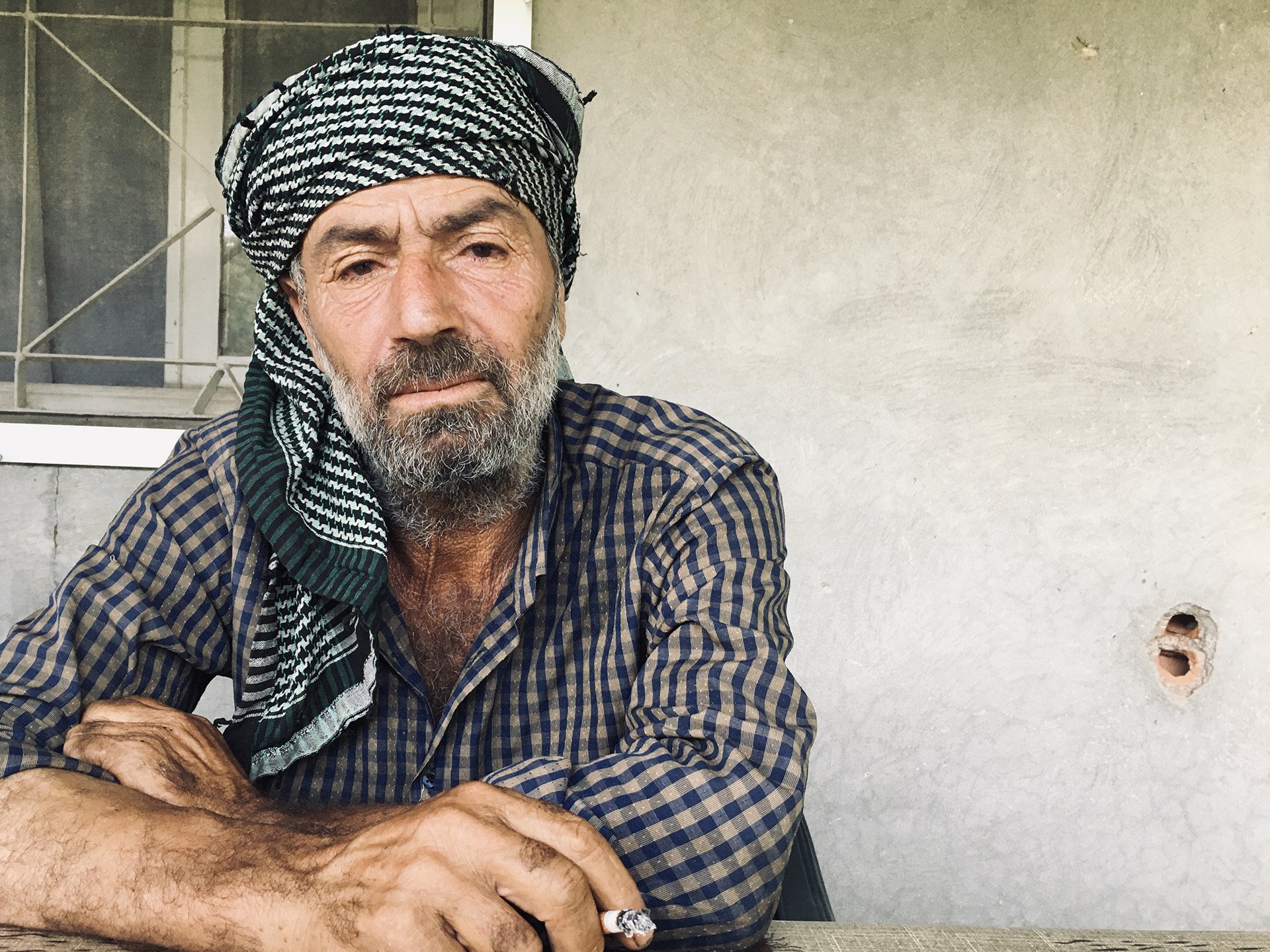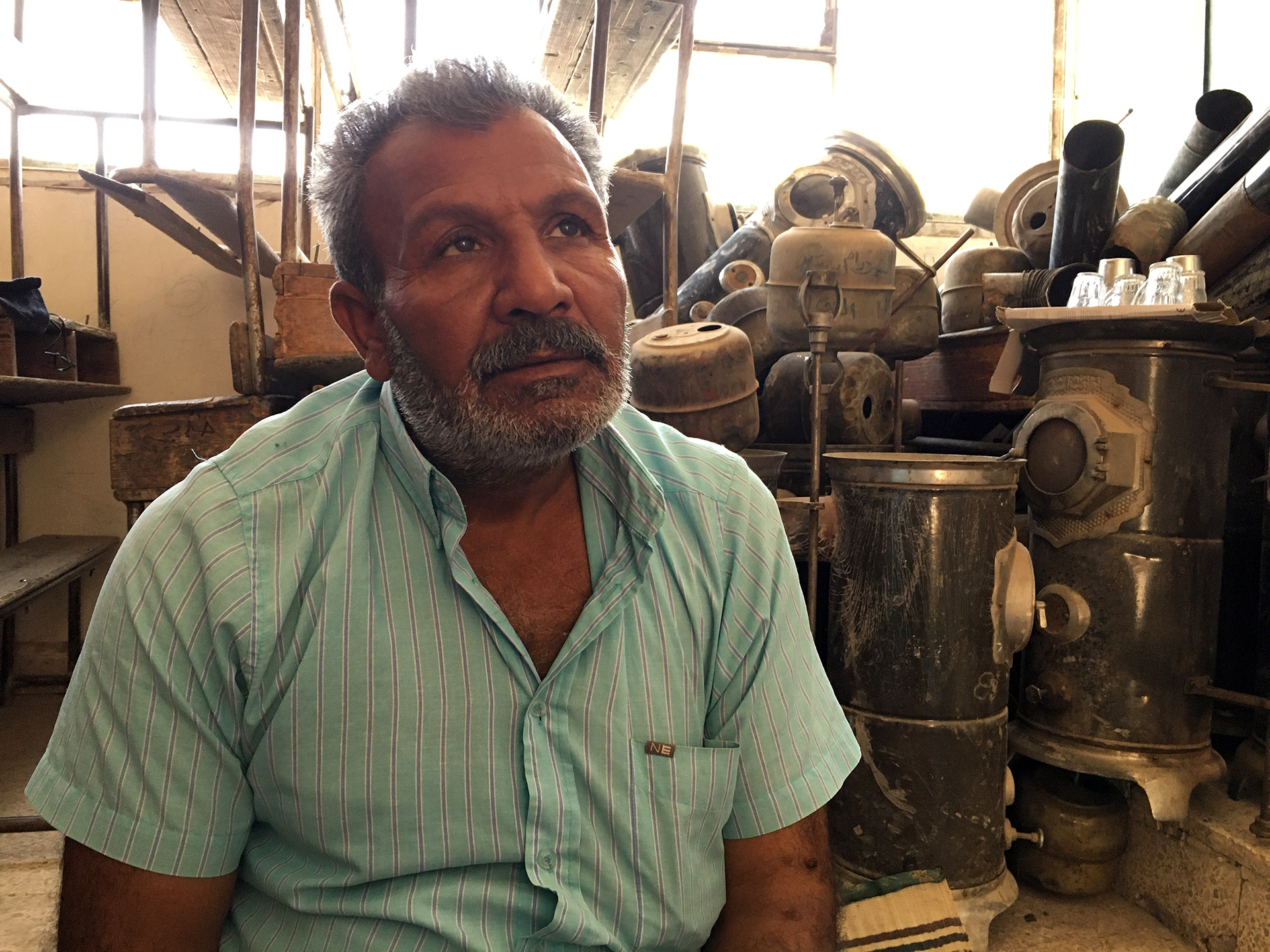In the past few weeks, Zozan Ayoub has gone from running a small primary school in northeast Syria to recording the names of people fleeing war, coordinating aid deliveries, and tending to the needs of the families now sheltering in her classrooms.
Her transformation from headteacher to citizen aid worker happened fast.
People began taking flight almost immediately after Turkey began an air and land incursion against Kurdish forces in the northeast on 9 October.
Some 22,000 of the 180,000 people the UN says fled the violence went to Hassakeh. Local authorities sent word to Ayoub, who lives and works in the city, some 80 kilometres from the Turkey-Syria border, to cancel classes and prepare for their arrival.
In a matter of hours, Ayoub and other staff members at the two-floor school had cleaned up and replaced desks with rugs and mattresses. By 12 October, some 274 people had descended on the school. It’s now Ayoub’s job to help them.
“Students will miss lessons,” Ayoub acknowledged. “But we have to provide for these people.”
The young headteacher is just one of many ordinary civilians who are pitching in to help the people impacted by clashes between Turkey and the Kurdish-led Syrian Democratic Forces (SDF) in the northeast.
Even though aid agencies, both local and international, are on the ground too, many have had to evacuate staff, and all are operating in a precarious situation.
“Access is limited and the situation on the ground is dire,” said Ken Isaacs, vice president of programmes and government relations for Samaritan’s Purse, a US-based NGO that works in northeast Syria. “Neighbours are helping neighbours, which is critical in a situation like this.”
Locals step in to help
Turkey’s invasion was followed by a series of fast-moving developments, including a five-day ceasefire, a deal between the SDF and the Syrian government, and, as of last week, a Russia-Turkey deal that will see the two countries patrol a “safe zone” on the border that Turkish President Recep Tayyip Erdogan has long pushed for.
The aid response has also had to move quickly, to keep up with both the civilian exodus from the border and the shifting security situation. While some people have gone back home as the fighting has calmed, the UN estimates that 106,000 people still cannot.
The UN, some 30 international aid groups, and approximately 200 NGOs are still active in northeast Syria, working to provide water, sanitation, shelter, and protection for those people. But the UN says suspensions by some NGOs, as well as evacuations of most international staff, have strained the response capacity and are likely to result in gaps.
The global humanitarian system is overstretched. In 2019, the UN says it needs $26.75 billion to help 109 million people in 58 countries. But only 52 percent of that funding has come through so far. In Syria, the UN has asked for $3.29 billion to help 11.7 million people in the country; so far it has just over half that amount.
What is local aid?
The global aid sector has broadly committed to an agenda to “localise” aid – putting more power in the hands of locals working on the ground where emergencies hit.
Why local aid?
The aim of of the “localisation” agenda is to improve humanitarian response by making it faster, less costly, and more in tune with the needs of the tens of millions of people who receive humanitarian aid each year. Local aid workers are closer to the ground, they have local knowledge and skills, they can often access areas that international aid groups can’t reach, and they know the needs of their own communities.
In Syria, the vast majority of aid workers – and the people taking on the most risk – are Syrians. Given how complicated it is to access some parts of the country, researchers say working with local organisations is not so much a choice as a necessity. But this has translated to only a small increase in aid funding to local groups.
Who are local aid workers?
Local humanitarian aid includes a broad spectrum of potential on-the-ground responders to crises and disasters: local NGOs, civil society groups and leaders, indigenous peoples, local governments, faith groups, as well as people who are themselves affected by crises. The global aid sector is also beginning to recognise the importance of so-called “informal” humanitarians, including the everyday volunteers that are the first to respond to emergencies in their own communities.
That’s where people like Ayoub come in. Across northeast Syria, local people have become temporary aid workers, collected food and clothes, or opened their homes to those in need.
Kadar Sheikhmous, director of Shar for Development, a Syrian NGO that works in the northeast, said regular people in displacement hotspots like Hassakeh or the nearby town of Tel Tamer were the first to step up and help. Before aid agencies had even started their emergency response, residents came out to offer support in any way they could, he added.
For example, Ayoub and her staff went from teaching children to managing a makeshift displacement site, and local families have been dropping off clothes, food, and medication.
Elsewhere, in the city of Qamishli, near the border with Turkey, 34-year-old Helin Othman has been doing her part, working overtime to deliver food baskets and diapers to displaced people.
Two years ago, the young Kurdish woman set up a Facebook group aimed at helping those affected by Syria’s ongoing conflict. These days, she is rallying the support of almost 50,000 online followers. Many regularly donate money and supplies.
Othman helped 250 displaced families in Qamishli and Hassakeh with food last week. “We send many products, mainly foodstuffs,” she said, sitting in the garden of her family home. Packed in black plastic bags, the packages contain jam, molasses, cans of chicken luncheon, tahini, and sesame oil; all staples of Syrian cooking.
Othman is reaching out to those who are staying with friends or family, rather than those in shelters like the Hassakeh schools, because even though these people are fortunate to have found a home to stay in, they are often off the radar of aid organisations.
“I called on the group members asking for help,” Othman said of the day the Turkish attacks began. “Not just for money, [but also] clothes, food, blankets – it depends on the person’s ability [to give].”

Shelter with strangers
The UN says most people displaced by the recent violence are like those Othman is trying to reach: they have found comfort in the homes of friends, families, and even strangers of a different faith.
In the Assyrian Christian village of Tel Nasri, some 40 kilometres northwest of Hassakeh, 150 mostly Sunni Muslim families from the border town of Ras al-Ayn have taken refuge in homes abandoned by the area’s persecuted Christian community.
The so-called Islamic State attacked the village, once home to more than 650 people, in early 2015, blowing up its church on Easter Sunday. Hundreds of residents were taken hostage and, while most were later released, only four families have come back: the rest moved out of the country or to larger cities in Syria.
According to three sources from the Assyrian community, all of whom asked to remain anonymous because they were not authorised to speak to the media, the owners of the houses, the local council in exile, and Syria’s Assyrian bishop (who could not be reached for comment), agreed to temporarily open their doors to those in need.
“Lots and lots of people have invited people into their homes. It has been inspiring; everyone is hosting someone,” said one aid worker familiar with the situation in the northeast who wished to remain anonymous so they could continue working in the area. “People are trying so hard to do anything they can, and that should be commended.”
Adapting to new needs
Despite the efforts of citizens who have stepped up, the lion’s share of aid work in the northeast is still being carried out by established NGOs. While there are challenges, they still have the greatest capacity, and funding, to scale up when large numbers of people need help.
But it is the local groups, often partnering with international NGOs, who are actually bringing water, food, and other necessities to people who need it. This was the case before the recent invasion, and many local groups are now nimble enough to change their focus when needed.
Shar for Development, for example, usually works on programmes that empower youth and women. It is now delivering emergency aid across the northeast.

A local NGO called Hevy partners with MercyCorps and is delivering food, hygiene kits, water, and bread in the northeast. Hevy told The New Humanitarian it would be delivering winter items like blankets this week.
“Because of the challenging security situation on the ground, locals are in a much better position to access and provide critical aid inside Syria,” said Isaacs of Samaritan’s Purse. “We are working hard to support them as much as we possibly can in those efforts. By working with local partners, we are also helping build their capacity for humanitarian relief.”
But some in the northeast still feel abandoned.
With approximately 850 volunteers, the Kurdish Red Crescent has been at the forefront of the emergency response since Turkey began its offensive.
“How did international organisations leave without giving any help?” spokesperson Ahmad Ibrahim asked, after many international aid workers left and other groups announced they were suspending operations.
It’s still not clear how volunteers and aid groups, local and international, will navigate the changing power dynamics in the northeast. Most of the territory had previously been controlled by the SDF, and NGOs knew how to work with their local administration.
But, the aid worker familiar with the situation in the northeast said, the recent deployment of Syrian government forces means many local aid workers no longer feel safe doing their jobs.
And while the SDF has presented its dealings with President Bashar al-Assad’s government as military and not administrative – meaning the Kurds still theoretically control the region – the situation remains volatile and humanitarian access uncertain.
Humanitarian actors are working behind the scenes to lobby for their own return to northeast Syria, but it remains unclear when most international workers will get back, and how supply lines will work in the future.
“We’re not political actors; we would work if the regime was there. It’s about filling humanitarian needs,” said the aid worker.
In the meantime, NGOs are doing what they can, civilians are filling in, and those who have fled are trying to make the best of a bad situation.
At Ayoub’s school, two displaced families volunteer to cook for everyone each day, in an attempt to maintain a semblance of normality amidst the chaos.
But neither this, nor any amount of aid, can replace home.
“We need blankets, food, and medication,” said Hussein Anin, sitting against the backdrop of old kerosene heaters and a mountain of school desks.
Anin fled Ras al-Ayn with just the clothes on his back. His family of six now sleep on a tiny patch of floor, surrounded by clutter. “We need our own place to stay,” he said.
With reporting support from Khabat Ibrahim
TNH used transportation provided by the Syrian Democratic Forces
sb/as/ag





